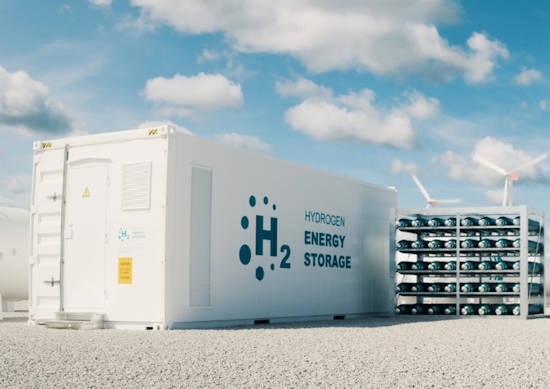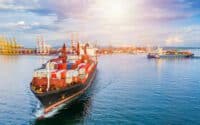Hydrogen and Ammonia: Unlocking a Sustainable Path for Global Shipping

I. The Current State of Maritime Fuels: A Context
Overview of the Existing Marine Fuel Landscape The maritime industry, responsible for a significant portion of global trade, predominantly relies on heavy fuel oil (HFO) as its primary energy source. HFO, derived from the residue of crude oil refining, has been the fuel of choice for ships due to its cost-effectiveness and high energy content. Other marine fuels like marine diesel oil (MDO) and marine gas oil (MGO) also find usage but are generally more expensive. The introduction of Liquefied Natural Gas (LNG) as an alternative has seen a gradual uptake, but the majority of the world’s fleet still runs on traditional fossil fuels.
* Please send feedback/suggestions to editor @ shipuniverse.com
Environmental and Economic Challenges Associated with Conventional Fuels Conventional marine fuels, especially HFO, pose significant environmental challenges. When burned, they release large amounts of sulfur oxides (SOx), nitrogen oxides (NOx), and particulate matter, contributing to air pollution and posing health risks to populations near major ports. The International Maritime Organization’s (IMO) regulations, like the 2020 sulfur cap, have been implemented to combat these emissions, but they also increase the operational costs for ship owners who have to invest in cleaner fuels or exhaust-cleaning systems known as scrubbers.
From an economic standpoint, the reliance on fossil fuels makes the shipping industry vulnerable to volatile oil prices. Fluctuations in global oil markets can drastically impact operational costs, making financial planning and forecasting challenging for shipping companies.
The Global Push for Cleaner and Sustainable Marine Energy Sources Driven by environmental concerns and the need for price stability, there’s a mounting global momentum to seek cleaner and more sustainable energy sources for shipping. International bodies, governments, and industry leaders are increasingly collaborating to research and promote green alternatives. Initiatives like the IMO’s strategy to reduce greenhouse gas emissions from ships by 50% by 2050, compared to 2008 levels, have further underscored the urgency to innovate and adopt sustainable marine fuels. This push is not just a response to regulations but a proactive endeavor to ensure that the maritime industry remains economically viable and environmentally responsible in the long run.
2. Exploring the Potential: Hydrogen in Shipping
Introduction to Hydrogen as a Fuel: Basics and Benefits Hydrogen, the most abundant element in the universe, presents itself as a promising fuel alternative for the maritime industry. When used as a fuel, hydrogen’s primary emission is water vapor, making it an environmentally friendly option. It can be produced using various methods, including electrolysis of water powered by renewable energy, making its production potentially sustainable. In terms of energy content, hydrogen has a higher energy density by weight compared to conventional fuels, although its energy density by volume is lower. This characteristic means that while a small weight of hydrogen can provide substantial energy, it requires larger storage spaces unless stored under pressure or at low temperatures.
Current Applications and Success Stories of Hydrogen-Powered Vessels The adoption of hydrogen as a marine fuel is in its early stages, but there have been noteworthy strides in its application. Several ferry services, especially in regions with stringent environmental regulations, have begun testing hydrogen fuel cells as primary or auxiliary power sources. For instance, the ‘Hydroville’ shuttle in Antwerp operates on hydrogen and serves as a proof of concept for larger-scale operations. Additionally, certain niche maritime sectors, such as inland waterway vessels, are exploring hydrogen due to the availability of refueling infrastructure in limited areas. These endeavors have demonstrated that hydrogen can provide reliable power, paving the way for its broader adoption in the industry.
The Challenges: Storage, Safety, and Infrastructure Needs Despite its promise, hydrogen integration in shipping faces multiple challenges. Storage remains a primary concern due to hydrogen’s low energy density by volume. Solutions like cryogenic storage, where hydrogen is kept at extremely low temperatures, or high-pressure storage systems are being explored, but they come with their own sets of technical and economic challenges.
Safety is paramount in the maritime sector, and hydrogen brings unique concerns. Given its wide flammability range and small molecule size, there’s a potential for leaks, which necessitates robust containment solutions and advanced sensor systems.
Infrastructure is another significant hurdle. For widespread adoption, ports globally would need to invest in hydrogen production, storage, and bunkering facilities. This requires not only substantial financial commitments but also regulatory alignments across nations. The industry’s shift towards hydrogen will thus be contingent on building this critical infrastructure.
III. The Promise of Ammonia: A New Maritime Fuel Frontier
Unveiling Ammonia: Understanding its Properties and Advantages Ammonia, or NH3, is a compound consisting of one nitrogen atom bonded to three hydrogen atoms. While traditionally used in agriculture as a fertilizer, it has garnered attention as a potential carbon-free marine fuel. Its allure primarily comes from the fact that, when burned, ammonia does not emit carbon dioxide. Another advantage is its liquefaction point, which is higher than that of hydrogen, making it somewhat easier to store and transport. Additionally, given that the global infrastructure for ammonia production and distribution is already substantial because of its agricultural applications, the maritime industry could potentially leverage this existing network.
Instances Where Ammonia Has Been Tested or Adopted in Shipping As the maritime industry searches for ways to meet the IMO’s greenhouse gas reduction targets, ammonia has emerged as a contender. Several shipping companies and engine manufacturers are in the early stages of testing ammonia’s feasibility as a marine fuel. MAN Energy Solutions, a prominent marine engine producer, has announced developments in engines that can run on ammonia. Furthermore, shipping giants like Maersk are actively researching ammonia as part of their efforts to decarbonize. Some pilot projects, particularly in regions with a robust green energy infrastructure, are considering “green” ammonia, produced using renewable energy, as a maritime fuel, indicating a budding interest in its potential.
Addressing Concerns: Production, Handling, and Emissions While ammonia’s potential as a marine fuel is promising, there are concerns that need addressing. The bulk of today’s ammonia is produced using the Haber-Bosch process, which relies on natural gas and results in CO2 emissions. For ammonia to be genuinely carbon-free, its production must shift to methods powered by renewable energy, like electrolysis using green electricity.
Handling ammonia comes with its set of challenges. It’s toxic, and a leak could pose serious health risks. Therefore, the storage and bunkering systems for ammonia would need to ensure utmost safety, both for the crew onboard and the environment.
Lastly, while ammonia doesn’t emit CO2 when burned, it does release nitrogen oxides (NOx), potent greenhouse gases. Engine designs and after-treatment systems would need to evolve to minimize these emissions and ensure that ammonia’s environmental footprint remains as low as possible.
Ammonia, with its dual role as a potential fuel and hydrogen carrier, certainly promises a new frontier in maritime propulsion. The journey, however, requires careful navigation of its challenges and a commitment to sustainable production and handling practices.

Do you have any feedback or additional insights? Please reach out to editor @ shipuniverse.com



